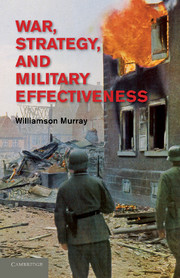Book contents
- Frontmatter
- Contents
- Introduction
- 1 History and the Future
- 2 Thucydides and Clausewitz
- 3 Clausewitz out, Computers in: Military Culture and Technological Hubris
- 4 Changing the Principles of War?
- 5 Military Culture Does Matter
- 6 History and Strategic Planning
- 7 Thoughts on Red Teaming
- 8 The Distant Framework of War
- 9 The Problem of German Military Effectiveness, 1900–1945
- 10 Reflections on the Combined Bomber Offensive
- 11 The Air War in the Gulf
- 12 Thoughts on British Intelligence in World War II and the Implications for Intelligence in the Twenty-First Century
- 13 The Meaning of World War II
- Index
- References
10 - Reflections on the Combined Bomber Offensive
Published online by Cambridge University Press: 07 October 2011
- Frontmatter
- Contents
- Introduction
- 1 History and the Future
- 2 Thucydides and Clausewitz
- 3 Clausewitz out, Computers in: Military Culture and Technological Hubris
- 4 Changing the Principles of War?
- 5 Military Culture Does Matter
- 6 History and Strategic Planning
- 7 Thoughts on Red Teaming
- 8 The Distant Framework of War
- 9 The Problem of German Military Effectiveness, 1900–1945
- 10 Reflections on the Combined Bomber Offensive
- 11 The Air War in the Gulf
- 12 Thoughts on British Intelligence in World War II and the Implications for Intelligence in the Twenty-First Century
- 13 The Meaning of World War II
- Index
- References
Summary
Of all the major campaigns of World War II, the Combined Bomber Offensive (CBO), the two-pronged attack by the Royal Air Force (RAF) and the U.S. Army Air Forces, still remains the most controversial. On one side there are the arguments typified by the economist and member of the U.S. United States Strategic Bombing Survey (USSBS), John Kenneth Galbraith, who argued that for all the effort and for all its hideous impact on “innocent” civilians, the CBO simply did not achieve anything of commensurate value. According to Galbraith, the CBO was “perhaps the greatest miscalculation of the war”:
German war production had, indeed, expanded under the bombing. The greatly heralded efforts, those on the ball-bearing and aircraft plants for example emerged as costly failures. Other operations, those against oil and the railroads did have military effect. But strategic bombing had not won the war. At most, it had eased somewhat the task of the ground troops who did. The aircraft, manpower, and bombs used in the campaign had cost the American economy far more in output than they had cost Germany.
Galbraith's deprecating comment, that at most the CBO had saved the lives of a few infantrymen, suggests a pervasive view that contrasts such small savings with the wreckage of some of the world's most cultured and beautiful cities.
- Type
- Chapter
- Information
- War, Strategy, and Military Effectiveness , pp. 231 - 264Publisher: Cambridge University PressPrint publication year: 2011



